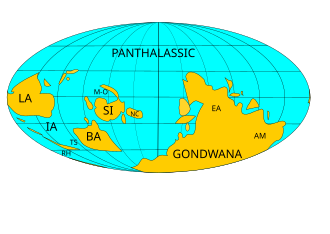
Siberia, also known as Siberian Craton, Angaraland (or simply Angara) and Angarida, is an ancient craton in the heart of Siberia. Today forming the Central Siberian Plateau, it formed an independent landmass prior to its fusion into Pangea during the Late Carboniferous-Permian. The Verkhoyansk Sea, a passive continental margin, was fringing the Siberian Craton to the east in what is now the East Siberian Lowland.
Angaraland was named in the 1880s by Austrian geologist Eduard Suess who erroneously believed that in the Paleozoic Era there were two large continents in the Northern Hemisphere: "Atlantis", which was North America connected to Europe via a peninsula (Greenland and Iceland), and "Angara-land", which would have been eastern Asia, named after the Angara River in Siberia.
Precambrian history
About 2.5 billion years ago (in the Siderian Period), Siberia was part of a continent called Arctica, along with the Canadian Shield. Around 1.1 billion years ago (in the Stenian Period), Siberia became part of the supercontinent of Rodinia, a state of affairs which lasted until the Tonian about 750 million years ago when it broke up, and Siberia became part of the landmass of Protolaurasia. During the Ediacaran Period around 600 million years ago, Protolaurasia became part of the southern supercontinent of Pannotia but around 550 million years ago, both Pannotia and Protolaurasia split up to become the continents of Laurentia, Baltica and Siberia.
Paleozoic history

Siberia was an independent continent through the early Paleozoic until, during the Carboniferous Period, it collided with the minor continent of Kazakhstania. A subsequent collision with Euramerica/Laurussia during the Late Carboniferous-Permian formed Pangea.
Mesozoic and Cenozoic history
Pangaea split up during the Jurassic though Siberia stayed with Laurasia. Laurasia gradually split up during the Cretaceous with Siberia remaining part of present-day northeastern Eurasia. Today, Siberia forms part of the landmass of Afro-Eurasia. To the east it is joined to the North American Plate at the Chersky Range. In around 250 million years from now Siberia may be in the subtropical region and part of the new supercontinent of Pangaea Proxima.
Features
- Akitkan Orogen
- Aldan Shield
- Anabar Shield
- Birekte terrane
- Daldyn terrane
- Magan terrane
- Olenyok Uplift
- Stanovoy tectonic zone
- Tunguska Basin
- Tungus terrane
See also
References
- Klets, A. G.; Budnikov, I. V.; Kutygin, R. V.; Biakov, A. S.; Grinenko, V. S. (2006). "The Permian of the Verkhoyansk–Okhotsk region, NE Russia". Journal of Asian Earth Sciences. 26 (3): 258–268. Bibcode:2006JAESc..26..258K. doi:10.1016/j.jseaes.2005.10.001.
- Permian bivalve mollusks of Northeast Asia, Fig. 1
- Sprague de Camp, L. (1970). Lost Continents: The Atlantis Theme in History, Science, and Literature. Courier Corporation. ISBN 9780486226682. Retrieved 25 October 2015.
- Xu, Yan; Han, Bao-Fu; Liao, Wen; Li, Ang (March 2022). "The Serpukhovian–Bashkirian Amalgamation of Laurussia and the Siberian Continent and Implications for Assembly of Pangea". Tectonics. 41 (3). doi:10.1029/2022TC007218. ISSN 0278-7407. S2CID 247459291.
- Schematic map of the Siberian craton showing boundaries of the craton and its terranes
- Schematic map of ancient terrains and kimberlitic fields in the Siberian craton
- YAKUTIAN KIMBERLITE PROVINCE: POSITION IN THE STRUCTURE OF THE SIBERIAN CRATON AND COMPOSITION OF THE UPPER AND LOWER CRUST
External links
- Blakey, R. "Global Earth History: Sedimentation, Tectonics, and Paleogeography of Asia". Northern Arizona University. Archived from the original on 16 June 2018. Retrieved 25 October 2015.(History of Siberia as well as other parts of Asia)
| Continents of Earth | |||||||||||
|---|---|---|---|---|---|---|---|---|---|---|---|
| |||||||||||
| |||||||||||
This palaeogeography article is a stub. You can help Misplaced Pages by expanding it. |










